This year Diwali and Islamic New Year coincided beautifully!
We being a Dawoodi Bohras, follow a Hijri Lunar calendar to date events in a year and have fixed number of days of each month based on Lunar Leap year, consisting of 355 days in a year which gets pushed back by 10 days every year with English calendar dates. The first month in Hijri calendar is Muharram and the last is Zilhajjatil-Haram, the month in which Muslims all over the world perform an annual pilgrimage to Mecca (Hajj). Muharram marks an important month in Islam in which a sacrifice was made and remind Muslims all over not of the glory of the community but of the heroic fight of good over evil; very similar to how Hindu festival of Diwali signifies the victory over heinous. So, on the very night that was Diwali, Bohras too celebrated the start of their New Year with full uproar!
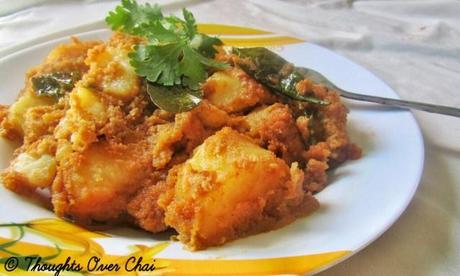
A little insight into the Dawoodi Bohra community would tell you, that they are predominantly business and trading community who are a sub-sect of Shia Islam. Dating back in Yemen, it evolved and spread across major parts of the World mainly being in India and Pakistan. Bohras take great pride in presenting their food and are firm believers of “family that eat together, stays together” and “live to eat”. Bohra meals are undergoing some major changes and you can now find variety of International dishes being served at weddings or certain occasions although with a mix of classical ethnic fare. Though most of the Bohras (including me) prefer eating on a dining table on daily basis, an age old tradition of eating out from a thaal (a big metal plate out of which 8 people can eat together) would never change, especially if you are in a mosque or attending a religious affair. Each dish from the thaal is brought at the center in turns and course by course. It is considered discourteous if one start eating from any bowl/plate without the permission of the eldest member in the thaal. The concept of eating in a thaal is to promote equality and unity; and it is thus proper to wait for everyone to finish one platter before proceeding to the other. The meal starts with a dessert followed by savory snacks and main meal at the end. As quoted in my previous post of Mango Souffle – Bohri Style Pudding, here’s some more -
We believe in holding opportunities to break bread together, be it any occasion or function. Typical menu in most of the Bohra’s affairs, depending on the occasion, will consist of atleast one sweet dish, one appetizer, followed by main course; which gets elaborated to two or three of the each dishes with salads and cold drinks if you are attending a wedding or a grand function.
Pehli Raat (a night before the first day of Islamic New Year) calls for an elaborate meal in every Bohra household that are sure to transport you to a food heaven. As you may have known, food plays a very evident role in our lives, so a dinner is planned days in advance and you can find most of the women on that day busy preparing a meal in the kitchen fit for a King! Sometimes the conventional way of serving and eating the food in my religion fascinate me to no end as much as it make me feel so close to my grounds. Maghrib or evening prayers are said, crisp sheeny clothes are worn and everyone gathers around a safra (a colored cloth on which the thaal is kept; more like a big napkin) wishing each other best compliments for the New Year and new beginnings. It’s customary for everyone in the family to sit around the thaal and start with mandatory rituals which will involve placing a coconut, betel leaf, betel nut, a silver coin, a spoonful rice and a raddish followed by tasting a grain of salt. Since this is the most religious day in the calendar apart from Eid, the relevant dishes of this day are Sodanna (cooked rice sprinkled with sugar and a dollop of ghee), Fried Fish (halal), Chana Bateta (cooked chickpeas with potatoes), Daal- Chawal Palidu (vegetarian rice dish with lentils, rice and a stew made from gram flour to which drumsticks are boiled and added) and Lachkaa (a sweet dish made from cracked wheat). Other variants of sweet and savory dishes can vary as well as array of fruits kept in the thaal depending on the varieties one want to display; items ranging from 7-21 in one sitting and some women even manage to shoot it to 52! The dishes also vary from the part of the world one belong to because Dawoodi Bohra is a vast community and widely spread across the globe. Each group of people coming from a different state/country have their own distinctive custom tidbits which are being traditionally followed over the years.
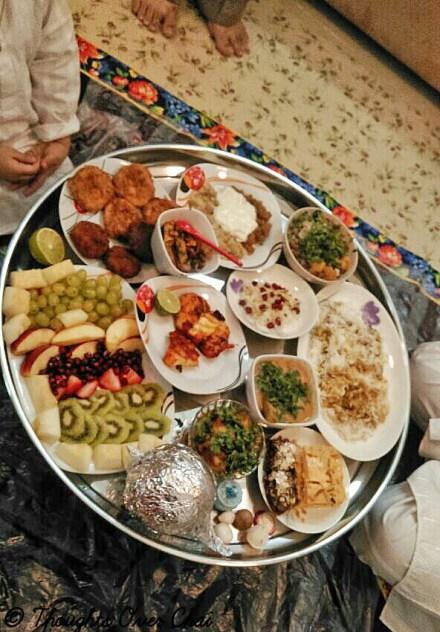
Preview of our thaal from that day.
When I lived in Hyderabad, we’d usually have to sit in two pehli-raat thaals, one at my nani’s house and the other at my uncle’s home. We’d be so full by the end of the night that it was difficult to breathe. When we shifted to Bombay, as soon as my mom would come home from work (in the afternoon), she’d set herself in the kitchen making varieties of eatables for a family of four while my sister and I would help her in peeling and cutting the vegetables and fruits which we would distribute amongst our neighbors before sitting for an extensive feast. Ditto formalities are being followed since I was a child and I have almost inherited same ethics to ensue in my new home. Just a day before, I’d take notes from mom over the phone on how to cook typical stuff like Lachka or Thuli. What I only miss here is the joy of eating in a thaal full of people instead of 3 of us in the house but the beaming faces of husband and Little A after the meal makes my heart feel contended and a day of hard-work went in to put a detailed meal pays off . After preparing a huge dinner of which we eat little of, no one is devoid of having leftovers so I skip making a lunch (or dinner may be) next day and eat what we ate on the previous day. This helps in wasting no food at all. And the fruits from the thaal get mostly converted into a fruit salad, fruit custard or a parfait to be had at breakfast!
Diwali has been celebrated with great enthusiasm and pom-pom in my household since many years and is also considered a significant day to start something new, more like a “shagun” (good omen). We light up the diyas (clay lamp), pray for prosperity, burst crackers and get involved in a hustle-bustle that the festival is popularly known for. When I lived in Hyderabad during the very early years of my life, all the cousins would gather money to buy all sorts of chakli, anar, rassi bomb, phooljadis, saanp tablets and other odds to use them at the night of Deepawali along with our neighbors on the roof of our nani/grandmother’s house. Later in the night after finishing up, we’d watch fireworks that still make through the next morning and tell stories that all would affectionately listen to. At that age, Diwali was all about having fun but over the years we have started understanding the true meaning of the day that it is. Nothing; I say nothing compares to the hoo-ha or the spectacular show of running around or the lightning up of streets back in home country. Usually it would feel like any regular day unless we make efforts to make it extra special. We say our evening prayers, light a row of diyas in the balcony and at the entrance and marvel at beautiful luminous lightnings dazzling out from the balconies. On this day particular, it amaze me how many Indians live in the same locality as I live in and yet get to see each other so sparingly. Bur Dubai is a different story altogether where long stretch of apartments and shops stand basking in thousands of neon lights and luminous lamps, that is unmatched anywhere else in UAE.
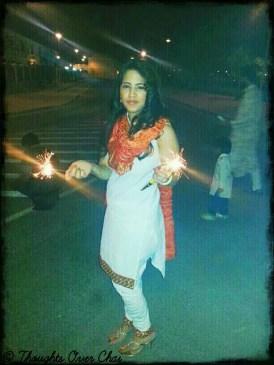
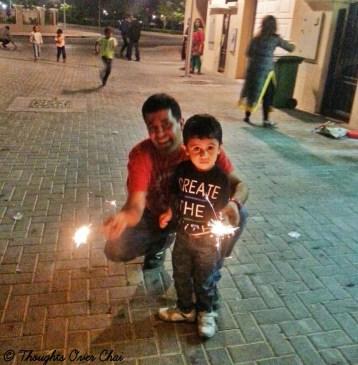 Lightning up the faces with phooljadi
Lightning up the faces with phooljadi And then there are festive seasons like these when most of the Indians miss family miles away from the home or country where we grew up in. While in the midst of busy lifestyle that we live, festivals and events give us an opportunity to pause for a moment and be thankful for what we have. Times may have undergone a sea of change and the way festivals are celebrated may have been altered over the years but the spirit, traditions and rituals remain the same; making us feel grounded, blessed and grateful for little joys that we keep overlooking for the remaining part of the year.
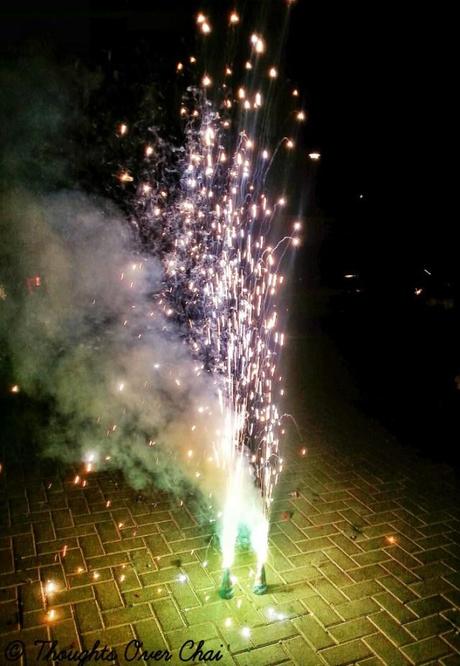
Another most popular dish to find in any Bohra household is spicy potatoes or masala waley aloo. It’s a quick and easy recipe of potatoes that makes for great appetizer at any given point. Can be also carried for picnics! It’s almost prepared at any given occasion to serve as a snack or kept as a side-dish or a salad. A great way to present this dish is to load them with spices (if you can handle) and sprinkle with oodles of coriander.
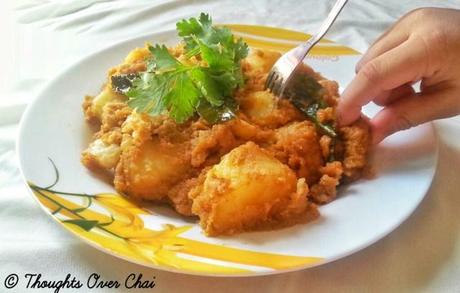
Little A in his usual element while I take a photograph!
Masala Waley Aloo or Spicy Potatoes Recipe.
Serves – 4
Ingredients:
- Baby Potatoes – 6, boiled and quartered.
- Tamarind Pulp – 2 tsp
- Red Chilli Powder – 2 tsp
- Whole Red Chilies- 2 nos.
- Cumin Seeds – 2 tsp
- Shredded Coconut – 2 tbsp
- Garlic – 8 to 10 cloves, peeled
- Curry Leaves – 10 to 12
- Cooking Oil – 2 tbsp
- Salt to taste
- Fresh Coriander – 1/4 cup, washed and chopped.
Method :
Boil the potatoes and peel them. Keep aside. Grind together coconut, red chilies, red chili powder, cumin seeds, tamarind pulp and garlic to a very fine paste, adding little water if necessary. Heat oil in a wok and add curry leaves. Let them splutter and add the ground paste. Cook for 2 mins till the oil start leaving from the sides. Add salt and mix. Carefully stir in the potatoes and coat them with the spices. Cover and cook on a low heat for about 2-3 minutes. Serve hot in a dish garnished with coriander.
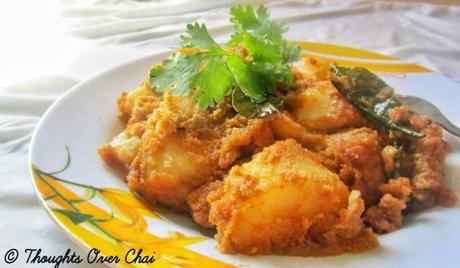
Here’s how the very two important events culminated ever so splendidly in my house. Do you have stories to share from your festivals, from your home? Wishing from my family to yours, a very Happy and Flourishing New Year. May this year bring in loads of prosperity, peace and happiness in your homes today and in years to come.
